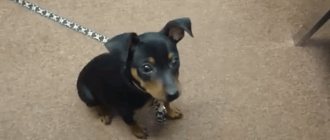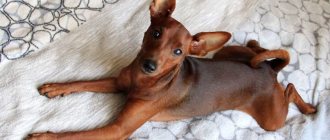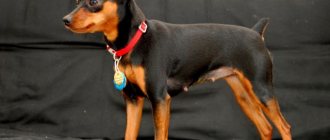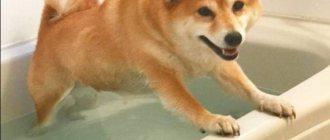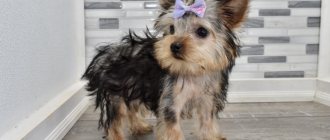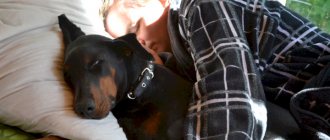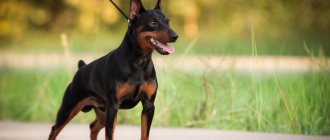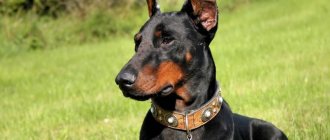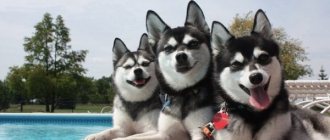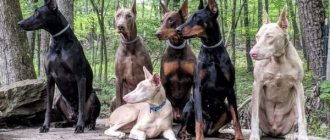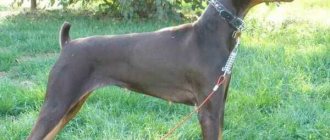The name of the miniature pinscher breed, which is difficult to pronounce, makes many people think. You won’t immediately remember what this dog looks like. Those who are familiar with the breed understand that this means a miniature pinscher or a mini Doberman. True, there is a distorted opinion about these dogs, since the animal is quite miniature in size. Everyone thinks that these miniature dogs are timid and stupid. Is it so?
Origin story
Connoisseurs of the German language understand by the name that the homeland of miniature pinschers is Germany. The first mentions date back to the fifteenth century. Dogs were owned by farmers who raised horses. The little pinschers did an excellent job of keeping rats out of the stables.
A little later, small animal hunters noticed them. The dog turned out to be very useful: it ate little, did not get tired for a long time, was very nimble and strong. Already in the nineteenth century, breeders paid attention to the breed. The breeding of an even smaller pinscher began. And in 1880 a breed standard was created.
The breed has gained recognition and fans around the world. The main purpose of the dog from now on is as a companion. It is interesting that the breeders managed to maintain the line, even despite the wars that raged in Europe.
History of the breed
The history of the mini Doberman goes back about 6 centuries. In the 15th century, in the German district of Württemberg, breeders developed breeds for the purpose of hunting small wild animals and rodents. It is not known for certain who exactly bred this type of dog. The miniature Doberman has always kept hunters company. Despite its small size, the dog coped well with the assigned tasks. A little later, he began to be involved as an escort for carriages. A small dog ran next to the cart and barked loudly, scaring away wild animals and other ill-wishers.
At the beginning of the 20th century, breeders paid attention to the unique breed. Dogs gained great popularity among residents of Europe and America after 1954, when they were demonstrated at one of the many English exhibitions. Small, beautiful and stately dogs are increasingly being kept in apartments. In Russia, the dwarf Doberman breed became widespread after the war.
Description and standard
The International Canine Association classifies the Mini Doberman as one of the smallest service dogs. It is recommended to use the dog in agility and freestyle.
Standard:
- Height from 25 to 35 cm;
- Weight from 4 to 7 kg;
- The body is elongated, with very smooth shiny hair, embossed;
- The dog's paws are quite long and thin, but powerful and developed;
- Eyes black or brown;
- Scissor bite;
- The dog's ears are protruding, straight and without creases;
- The tail is high and straight;
- The color can be one-color (various shades of brown) or two-color (black and brown).
Many people believe that in order to participate in the exhibition, a miniature pinscher must have cropped ears, like the Doberman breed. However, there is no such rule. The exhibition includes individuals with any type of ear design. The same goes for the tail.
Description of the Miniature Pinscher breed
The characteristics of the Miniature Pinscher breed are based on standards. Over time, standards have changed. The changes made, however, did not greatly affect the appearance of the dog.
Not so long ago it was necessary to crop the ears and tails of miniature pinschers. Following the passage of legislation in many countries prohibiting such actions, the FCI standard was revised. Currently, docking is not a mandatory requirement and is performed at will.
Size and appearance
According to the standard, the description of the miniature pinscher breed is as follows:
- The height of an adult pet should be from 25 to 30 at the withers;
- Weight is 4 – 6 kg.
All deviations are unacceptable and may result in disqualification from the show.
In appearance, he is almost a copy of the Doberman. The little Doberman Pinscher, like its big twin, has two coat colors. Color varieties: red in all shades of brown and black and tan with a highlighted area near the eyes, the inside of the paws and the chest.
The body is muscular, dry, strong. Correct physique. The paws are placed at a distance. The eyes are dark and normally set. The eyelids are also dark. The teeth are strong and white. Scissor bite. The neck is moderately long and strong. The skin is dense and fits without any folds. Smooth-haired, has no undercoat. The tail is docked or saber-shaped.
Lifespan
With proper care for your pet, the life expectancy of a mini Doberman reaches 15 years. Such a long period of life of the miniature pinscher is due to the general strength of the body. But this requires proper nutrition and care for the miniature pinscher from puppyhood.
Character
The character of the miniature pinscher is ambiguous. These dogs are very cheerful and active. They will always find something to do and amuse their owners. But these are very proud animals, with a certain amount of aristocracy. She will not tolerate boorish attitude even from her beloved owner. At the same time, they are very loyal creatures. For the sake of the owner, German miniature pinschers are ready to rush at an opponent much larger than themselves. They may be somewhat intolerant of guests and other pets. Smart and balanced, he will not make noise over trifles. It is also a friendly and resourceful pet, it will always be able to adapt to any circumstances.
Intelligence
Miniature Pinscher dogs are very smart. They will not rush head-on at an obviously stronger enemy, but they will not yield to him either. Ingenuity will help dogs of this breed find a way out. They will also easily find something to play with even when alone. For this reason, it is worth removing items that can be chewed higher. Their intelligence and ability to think are at a very high level, so they will always find a way out of the current situation. High intelligence makes it easy to learn skills for which the breed was not originally adapted.
Attitude towards others
The Miniature Pinscher's friendliness makes him a very sociable animal. Completely devoted to their owners, they can be jealous of other pets or guests. But they love to play and interact with both people and other animals.
Thanks to these qualities, they will become best friends. Just don’t forget to wear a leash while walking – the little protector can rush at anyone, even a very large enemy.
Attitude towards children
For children, a miniature pinscher - a miniature pinscher - will be the best friend. He loves to play thanks to his irrepressible energy. For this reason, they get along great and can become best friends. However, you should not leave them alone with children. A baby can unknowingly cause pain to a pinscher. In this case, the dog will defend itself. If you have a child under one year old, you should wait to choose this dog. Loud barking can frighten or wake up your baby.
Training and education
It is important to remember about training your miniature pinscher. It should be started no later than 3-4 months. The nervous system of a puppy at this age is already fully formed, he is ready to recognize and fulfill the requirements. Like any other breed, Pinschers vary in personality. You need to train based on the individual inclinations of each dog. It is recommended to consult a dog trainer. It is necessary to train these active animals in the form of a game, but ensuring that the command is carried out completely. You need to start with simple commands, gradually moving on to more complex ones.
You shouldn’t be touched by your pet’s pranks, letting go of trifles. He will instantly understand the situation and in the future may begin to manipulate the owner. From the first days you need to let your pet feel who is boss in the house. However, you shouldn’t push it and be too harsh. The miniature pinscher does not tolerate this kind of attitude.
Character and behavioral characteristics
This mini dog has a very difficult temperament. Many people mistakenly associate this with the fact that he is supposedly related to the Doberman Pinscher. This is wrong. The Doberman Pinscher was bred by a breeder who admired miniature pinschers and decided to breed a similar dog, but larger. The ancestor of these dogs is the German Pinscher.
The owner will have to be very careful. There is a great temptation to force your pet to obey, since he is very small. This will lead to problems. It takes a lot of patience.
In addition to its complex character, the dog is very inquisitive and playful, good-natured and very active. They love children and outdoor games with them. However, they can become an excellent companion for older people.
There are some disadvantages that are worth paying attention to:
- They do not tolerate competition from other pets in the family;
- Passion for digging. Everything in the apartment that they can get to will be subject to digging;
- They chew objects throughout their life;
- The guard instinct is highly developed, so they often provoke other dogs.
Education and training
From an early age you will have to take a leading position in relation to the pinscher, otherwise he will take it himself and become uncontrollable and stubborn. Amenable to training if you turn it into a game, he will happily follow any orders. For this breed, if it is trained, a simple raising of the owner's voice or gaze is sufficient. Physical force is unacceptable under any circumstances.
Character
The dog is distinguished by its mobility and energy. This type of dog has very developed intelligence. The miniature pinscher is considered an intelligent and quick-witted animal that is easy to train. True, he has a rather proud, capricious and stubborn character. The dog absolutely does not tolerate careless attitude towards his own person. Therefore, it is recommended for adults, and possibly retirees, to have a pet of this breed.
You can't pamper your Pinscher all the time. Without proper upbringing, he can very quickly get used to his master's kindness and become spoiled and uncontrollable. The dog needs an experienced breeder with a strong spirit and strong character who can keep the pet on a “short leash.” You need to practice quite a lot with a pet. If another animal grows in the same house with the pinscher, then its friendship with its neighbor will be strong. Growing up, mini Dobermans do not forget their brothers. But if you get another pet in the territory already mastered by the pinscher, a war will begin between the animals. He perceives new neighbors very aggressively, so in order to avoid eternal enmity, it is better not to take risks.
Diseases
Life expectancy is quite long - on average 15 years. This is a lot for a small dog. Health is good; with proper care, the dog is little bothered by illness.
There are specific health problems and threats:
- They are very at risk of frostbite during cold periods;
- Development of diabetes mellitus;
- Pathologies of the thyroid gland;
- Eye pathologies: cataracts, glaucoma;
- Joint dislocations;
- Deafness;
- Epilepsy.
To prevent all diseases, you need a high-quality diet, care and a lot of attention. The dog is very susceptible to temperatures, low and high. Therefore, in the heat, you must always have water with you to cool your pet, and insulate it in winter. For them, clothes are not a funny accessory, but a necessity.
Maintenance and care
This breed is exclusively for indoor use, not outdoors. An animal should have its own place in the house. You need to understand that a representative of this breed will jealously guard it, so it is better to clean it in his absence.
Needs long walks outside, during which the owner will play outdoor games with him. It's better not to let him off the leash. When leaving him at home alone, you need to offer him a whole arsenal of toys.
Rules of care:
- Mini Dobermans are very rarely dirty. Therefore, after a walk, it is enough to dry your pet’s fur with a towel;
- Pinschers are washed several times a year. More frequent washing leads to colds and flaking of the skin;
- Shedding is insignificant; no brushing is required;
- Ears and claws need attention.
Never carry your Pinscher by the scruff of the neck. The dog will have a painful tendon injury.
In order to protect your pet from diseases, he needs to purchase clothes for the cold season. It should not be tight and made of warm and water-repellent material.
Pros and cons of the breed
The mini Doberman dog has its own distinctive characteristics. Therefore, before getting a pet, it is worth weighing all aspects of such an acquisition:
| Characteristics | pros | Minuses |
| Shedding | Easy to carry. It is enough to wipe the fur with a special brush or damp cloth whenever possible. | |
| Care | It doesn't take much time to leave the owners. Standard procedures are needed - cleaning the eyes and ears, trimming the nails. | |
| Security qualities | Barks loudly at the sight of strangers. Has excellent reaction. A mini Doberman is capable of rushing at a stranger if he threatens the owner and other family members. | |
| Physical exercise | Long-term training is necessary, otherwise the dog will begin to spoil household things. | |
| Training | Excellently trainable. Loves spending time with the owner. He is happy to follow commands and fetch a stick or ball. | |
| Get along with children | Good with older children. | Doesn't like it when small children pull its fur or tail. It can snap and growl at the baby, and sometimes even bite lightly if the baby is too persistently tugging at various parts of the dog’s body. |
| Living with other animals | He is friends with other pets with whom he grew up. | Not friendly, reacts aggressively to new acquaintances with animals. |
| Contents in the apartment | Suitable for living in an apartment, even a small one. | |
| Agility | Loves active games and running. |
In general, a miniature pinscher dog is an excellent friend and playful companion for outdoor games. However, it is worth considering that the little Doberman loves to bark. Moreover, his voice is very clear. Getting a miniature Doberman puppy is best for those people who have a lot of free time. If you don't take care of your pet and don't raise it, there is a risk of getting a stubborn animal.
Feeding
Pinschers eat little, so the owner has more opportunities to create a varied diet. It should include:
- Almost 40% of the daily diet is protein (raw or cooked meat);
- Oatmeal and buckwheat in the form of porridges;
- Be sure to add boiled vegetables with a drop of vegetable oil.
Food is given according to a schedule, otherwise overeating is possible. Water is not limited. If the owner decides to feed the animal with ready-made food, then you need to choose only the super premium class. There are no unnecessary impurities in these feeds. It is worth choosing specialized food, labeled “for small breeds.”
How to choose and where to buy a puppy
When choosing, pay a lot of attention to the breeder. Is it just business for him or is he a true dog lover. This will be evident in the way he talks about the puppies.
Pinscher litters are very small - on average one or two babies. Choosing a puppy on your own is difficult. Voice your plans for the dog to the breeder, and he will recommend you a specific baby.
You only need to buy a kitten from a nursery; this is the only way to be guaranteed to buy a friend who will be free from diseases and will become a prominent representative of the breed. The breed is not rare and there are many breeding kennels.
The price of miniature pinscher puppies ranges from $300 to $900.
How to choose a miniature pinscher puppy
Before you go get your miniature pinscher puppy, make sure everything is ready for your pet's arrival. It is necessary to remove higher objects that can be chewed - wires, small objects, shoes, etc. Give him a place where the dog can be alone and relax. It is worth laying a soft, warm bedding there. The place should be warm, without drafts and not near heating radiators. A tray and bowls for food and water should be available to the puppy at all times. It is worth making sure that you can easily clean it up after feeding. You need toys that the miniature pinscher can chew. At the same time, you should not give your old slipper to be torn to pieces - the puppy will get used to the toy and begin to chew all the shoes. Take care of a leash, harness, and warm overalls for walking in advance.
After this, you can go to the breeder. Sit down and call all the puppies at once. Healthy puppies are always active and curious; they will be the first to run up to a stranger. Watch them eat. A healthy pinscher eats everything and very quickly. There's no need to rush. We need to let them get comfortable and start playing. At this time, you can easily notice distinctive character traits. Some will be calmer, others will be active, and others may be aggressive.
You also need to evaluate the appearance. The coat should be smooth, without bald spots, but scratches that puppies can get while playing are allowed. Eyes and ears are clean. There should be no unpleasant odors from the mouth and ears.
Last but not least, you need to pay attention to your mother. Only a healthy dog can produce and produce healthy offspring. The dog must be strong, not thin, with external signs of health and a good appetite.
Once the dog is selected, you need to bring it home and let it sniff quietly. Let him see where everything is and get used to the new smells. After this, you need to show him the place and a bowl of water. Tray training should occur gradually.
The price of a puppy with a pedigree varies from 10 to 30 thousand rubles.
Puppies with good pedigree are more expensive than puppies that are not suitable for showing. If you plan to take a dog not for a show, but for the soul, you can take it for a lower price from your own hands. Although we cannot talk about pedigree in this case, attention must be paid to the health of the dog. For exhibitions, it is better to buy from breeders with a good reputation and a large number of positive reviews.
We recommend similar breeds
| Italian Greyhound | Chihuahua | Basenji |
